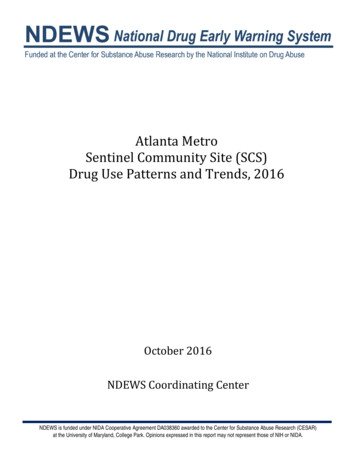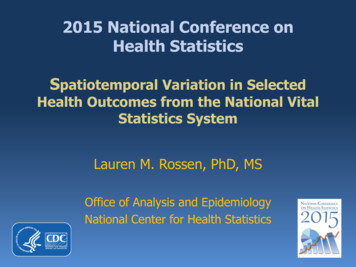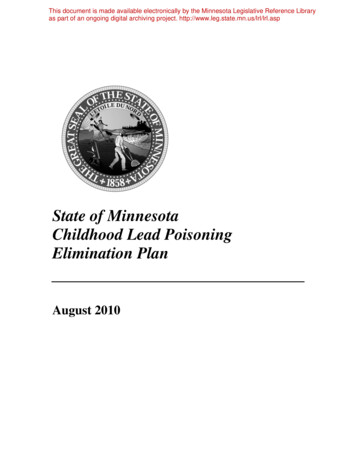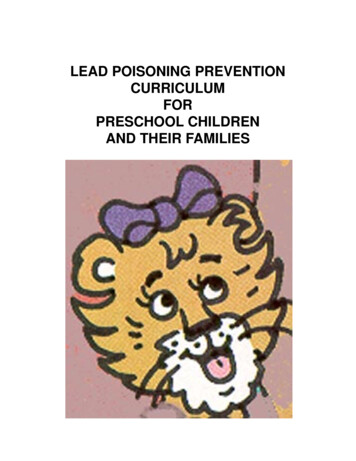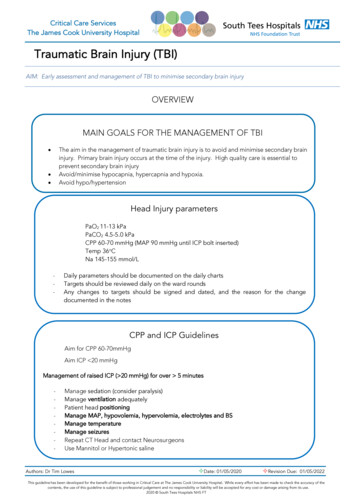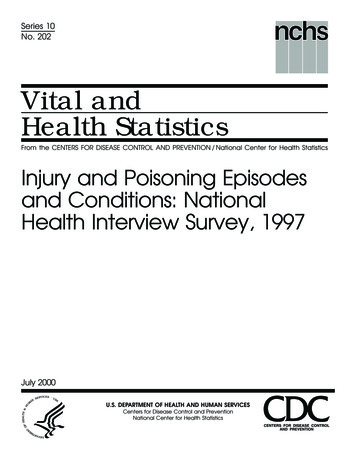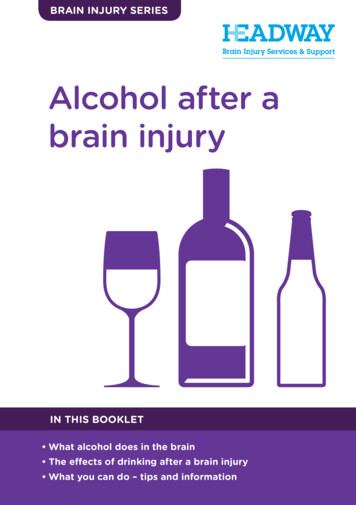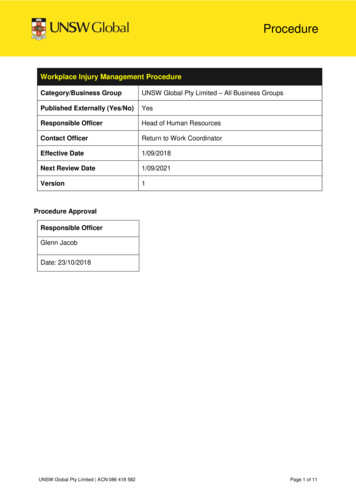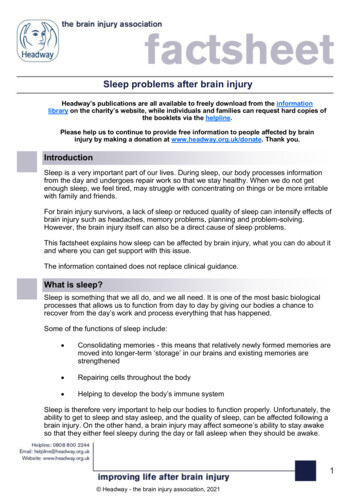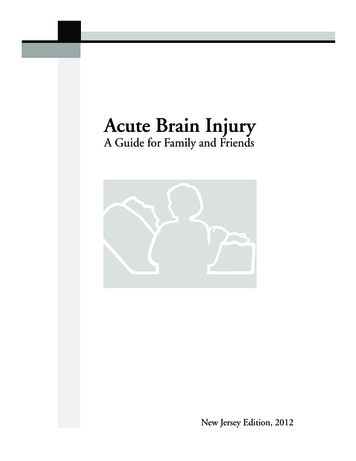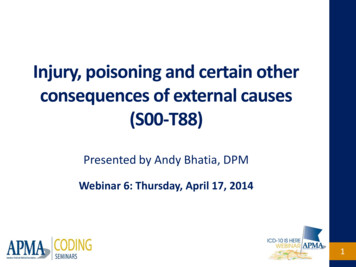
Transcription
Injury, poisoning and certain otherconsequences of external causes(S00-T88)Presented by Andy Bhatia, DPMWebinar 6: Thursday, April 17, 20141
APMA Educational Information:ICD-10 Webinars Register for upcoming webinarsView archived recordingsDownload PDF versions of each presentationapma.org/icd10ishere or apma.org/webinarsCoding Resource Center apmacodingrc.orgQuestions Contact the Health Policy and Practice Department coding.hpp@apma.org or 301-581-92002
ICD-10-CM Resourceswww.apma.org/icd103
APMA Coding Resource Centerwww.apmacodingrc.org ICD-9 to ICD-10 crosswalks are now available.4
ICD-10-CM Guidelines - CHAPTER 19Injury, poisoning and certain otherconsequences of external causes (S00-T88)The S section provides codes for the various typesof injuries related to single body regions;The T section covers injuries to unspecified bodyregions as well as poisonings and certain otherconsequences of external causes.5
ICD-10-CM Guidelines - CHAPTER 19S70‐S79 Injuries to the hip and thighS80‐S89 Injuries to the knee and lower legS90‐S99 Injuries to the ankle and footT07 Injuries involving multiple body regionsT14 Injury of unspecified body regionT15‐T19 Effects of foreign body entering throughnatural orifice6
ICD-10-CM Guidelines - CHAPTER 19T20-T32 Burns and corrosionsT33‐T34 FrostbiteT36‐T50 Poisoning by, adverse effect of and underdosing of drugs, medicaments and biological substancesT51‐T65 Toxic effects of substances chiefly non-medicinalas to source7
ICD-10-CM Guidelines - CHAPTER 19T66‐T78 Other and unspecified effects of external causesT79 Certain early complications of traumaT80‐T88 Complications of surgical and medical care, notelsewhere classified8
GUIDELINES: Chapter 19 Most categories in Chapter 19 have seventhcharacter extensions that are required for eachapplicable code, and most categories have threeextensions (with the exception of fractures): A, Initial encounter D, Subsequent encounter S, Sequela9
GUIDELINES: Chapter 19The S extension identifies the injury responsible forthe sequela. The specific type of sequela (e.g.,scar) is sequenced first, followed by the injurycode. Sequela terminology in ICD-10-CM replacesthe late effects categories (905–909) in ICD-9-CM.10
GUIDELINES: Chapter 19 - Fracture Coding ICD-10-CM fracture codes can indicate thefracture type (e.g., greenstick, transverse, oblique,spiral, comminuted, segmental), specificanatomical site, whether the fracture is displacedor not, laterality, routine versus delayed healing,nonunions, and malunions. Laterality and type ofencounter (initial, subsequent, sequela) aresignificant components of the code expansion.11
GUIDELINES: Chapter 19The fracture extensions are expanded to include: A, Initial encounter for closed fracture B, Initial encounter for open fracture D, Subsequent encounter for fracture with routine healing G, Subsequent encounter for fracture with delayed healing K, Subsequent encounter for fracture with nonunion P, Subsequent encounter for fracture with malunion S, Sequela12
GUIDELINES: Chapter 19In ICD-10-CM a fracture not indicated as displacedor nondisplaced should be coded to displaced,and a fracture not designated as open or closedshould be coded to closed.13
GUIDELINES: Chapter 19 - Poisoning, AdverseEffects, and Underdosing of DrugsCodes in categories T36–T65 are combination codesthat include substances related to adverse effects,poisonings, toxic effects, and underdosing, as well asthe external cause. No additional external cause codeis required.ICD-10-CM includes a table of drugs and chemicals14
GUIDELINES: Chapter 19 - Poisoning, AdverseEffects, and Underdosing of Drugs ICD-10-CM includes a table of drugs and chemicals withfour columns with headings related to poisonings. Accidental (unintentional) Intentional (self-harm) Due to assault Undetermined There is also a fifth column with the heading “AdverseEffects” and a sixth column with the heading“Underdosing.”15
GUIDELINES: Chapter 19 - Burns andCorrosionsBurn codes apply to thermal burns (except sunburns)that come from a heat source, such as fire or hotappliance. They include electricity and radiationburns. Corrosions are burns due to chemicals. Theguidelines are the same for burns and corrosions.16
GUIDELINES: Chapter 19 - Burns andCorrosions Current burns (T20–T25) are classified by depth,extent, and agent (X code). Burns are classified bydepth as first degree (erythema), second degree(blistering), and third degree (full-thicknessinvolvement). Burns of the eye and internal organs(T26–T28) are classified by site, not by degree. Use an additional code for the infection. When codingburns, separate codes for each burn site should beassigned.17
Bite on foot18
SUBJECTIVE Pt is a 42 y/o Male that presents for suspected spiderbite to dorsal right foot. He is s/p 3 days. He went to an urgent care center immediately and had adrainage done of open abscess at that time by Dr. Dre. Pt did not accurately recall exactly if it was a spiderbecause he was extremely drunk and walking around hisgarage and felt a sharp pain. He has been doing dressings daily with gentamicin creamand dry dressing. He is taking Doxycycline, and for pain,Ibuprofen. He thinks he is doing better.19
HISTORY Allergies : No Known Allergies Current medication: Doxycycline and Ibuprofen forcurrent situation Past medical/surgical history: unremarkable Social history: 1 pack of cigarettes a day x 20 years. 12pack of beer daily Family history: Liver disease- mother20
Review of Systems Systemic: No fever, no chills. GI : No nausea or vomiting. Endocrine: No excessive sweating. Musculoskeletal: back pain due to ridingmechanical bull yesterday.21
OBJECTIVE General Appearance: Alert. Oriented to time, place,and person. In no acute distress. Arterial Pulses: Posterior tibialis pulses were normal.Dorsalis pedis pulse on Left was normal, on Right footnot palpated due to wound. No evidence of hematoma. Edema: 2 non-pitting Skin: Foot, right: : Slightly warm, slight tenderness onpalpation. No odor, slight serous drainage.22
OBJECTIVE cont. Neurologic status: no numbness noted and intactDTR bilateral. Physical findings: Height : 5ft 10 inchesWeight : 140 pounds; BP : 115/80; Pulse : 6523
ASSESSMENT Bite, spider, healing wound, no complication24
PLAN Continue current plan of care. Finish antibiotic.Return in 7 days.25
ICD -9 892.1 Open wound of foot except toe(s) alone,without mention of complication 917.4 Insect bite, nonvenomous, of foot andtoe(s), without mention of infection E906.4 Bite of nonvenomous arthropod26
ICD – 10 mapping for 892.1Injury, poisoningand certain otherconsequences ofexternal causesS00-T88Injuries to theankle and footS90-S99S91 Open woundof ankle, foot andtoes27
ICD- 10 mapping for 892.1S91.3Openwound offootS91.351AS91.35Open biteof footS91.351Open bite,right footOpen bite,right foot,initialencounter28
ICD – 10 mapping for 917.4S00-T88Injury, poisoningand certain otherconsequences ofexternal causesS90-S99Injuries to theankle and footS90Superficial injuryof ankle, foot andtoes29
ICD- 10 mapping for 917.4S90.8Other superficialinjuries of footS90.86S90.861Insect bite(nonvenomous)of footInsect bite(nonvenomous),right footS90.861AInsect bite(nonvenomous),right foot, initialencounter30
Similarly, the final code can be arrived at as such: Chapter 20 External causes of morbidity V00Y99 Exposure to animate mechanical forcesW50-W64 Bitten or stung by nonvenomousinsect and other nonvenomous arthropods W57 W57.XXXA Bitten or stung by nonvenomousinsect and other nonvenomous arthropods,initial encounter31
Another method of getting to thesame ICD -10 codes is to use thealphabetical Index.32
ICD-10 Diagnosis Index2013 ICD-10-CM Alpha Index 'A' terms (702) 'B' terms (395) 'C' terms (716) 'D' terms (408) 'E' terms (347) 'F' terms (261) 'G' terms (265) 'H' terms (559) 'I' terms (208) 'J' terms (32) 'K' terms (106) 'L' terms (331) 'M' terms (593) 'N' terms (202) 'O' terms (245) 'Ö' terms (1) 'P' terms (852) 'Q' terms (14) 'R' terms (253) 'S' terms (684) 'T' terms (368) 'U' terms (109) 'V' terms (148) 'W' terms (107) 'X' terms (18) 'Y' terms (7) 'Z' terms (12)33
Under “B”, you will find: Bite(s) (animal)(human) Under that, looking alphabetically you will find: Foot (except toe(s) alone) S91.35 This leads to: S91.351 Open bite, right foot And finally to: S91.351A Open bite, rightfoot, initial encounter34
Similarly you have the ICD-10-CMExternal Cause Alpha Index 'A' terms (22)'B' terms (20)'C' terms (29)'D' terms (17)'E' terms (15)'F' terms (21)'G' terms (2)'H' terms (15)'I' terms (19)'J' terms (2)'K' terms (4)'L' terms (11)'M' terms (16)'N' terms (5)'O' terms (6)'P' terms (18)'R' terms (12)'S' terms (41)'T' terms (18)'U' terms (2)'V' terms (4)'W' terms (9)35
Under “B”, you will find: Bite, bitten by Under that, looking alphabetically you will find: Spider (nonvenomous) W57 Bitten or stung bynonvenomous insect and other nonvenomousarthropods This leads to: W57.XXXA Bitten or stung bynonvenomous insect and other nonvenomousarthropods, initial encounter36
SUBSEQUENT VISIT CODING S91.351DOpen bite, right foot, subsequent encounter S90.861DInsect bite (nonvenomous), right foot, subsequentencounterW57.XXXD Bitten or stung by nonvenomous insect andother nonvenomous arthropods, subsequent encounter37
SEQUALAE CODING S91.351SOpen bite, right foot, sequela S90.861SInsect bite (nonvenomous), right foot, sequelaW57.XXXS Bitten or stung by nonvenomous insect and othernonvenomous arthropods, sequelaExtension S, sequela, is used for complications or conditions thatarise as a direct result of an injury, such as scar formation after aburn. The scars are sequela of the burn. When using extensionS, it is necessary to use both the injury code that precipitatedthe sequela and the code for the sequela itself. The S is addedonly to the injury code, not the sequela code.38
Comparing ICD-9 and ICD-10ICD-9ICD-10892.1 Open wound of foot except toe(s) S91.351Aalone, without mention of complication Open bite, right foot, initial encounter917.4 Insect bite, nonvenomous, of foot S90.861Aand toe(s), without mention of infection Insect bite (nonvenomous), right foot,initial encounterE906.4 Bite of nonvenomous arthropodW57.XXXA Bitten or stung bynonvenomous insect and othernonvenomous arthropods, initialencounter39
Phalanx Fracture with Laceration40
SUBJECTIVE 21 years old female presents with a chief complaint ofinjury to her right great toe. She stubbed her right great toe severely against the chairwhile in the kitchen. This caused great pain and discomfort and it soon beganto swell and turn red, black, and blue. There was slighttemporary bleeding. It is very sore to put weight on thefoot and she cannot get a shoe on this foot. The injury occurred while cooking at the patient's home. This occurred this afternoon41
HISTORYPast Medical History: NoneMedication: Multivitamin dailyAllergies: SulfaFamily history: Mother has diabetesSocial history: non smoker and social alcohol use. Shedoes not claim to be drinking at the time of injury ROS: Musculoskeletal: ( ) right foot pain 42
OBJECTIVE Vital Signs: 5ft 9 inches 137 pounds BP 110/68, pulse 64,respirations 24, temperature 98 Patient is well oriented to time and place and is able tocommunicate with me about her problems. Vascular examination shows palpable pulses bilateral. Neurologic; DTR are intact and tactile sensation is good Dermatologic evaluation reveals swelling and discolorationaround the right great toe. The right hallux is very swollen and tender to touch all over.The tip of the toe has some avulsion of the skin. It is partialthickness. The nail has also been damaged severely.43
TESTS X-Ray, 3 views of right foot with toe elevatedshowed a closed nondisplaced fracture of distalphalanx of right great toe. The general appearance of the bone is normalfor the age and gender of the patient.44
ASSESSMENT Closed Nondisplaced fracture of distal phalanxof right great toe Laceration of right great toe, partial thicknesslaceration45
PLAN Discussed the need for adequate immobilization becauseof fracture and needing wound care to laceration.Wound was cleansed and dressed with gentamicin creamand dry dressing. Patient consents to walking bootimmobilization which was dispensed with instructions-non-pneumatic, without joints, with interface material,prefabricated, with fitting and adjustment. Instructed to walk as less as possible, elevation, and a Rxfor Ibuprofen.46
PLAN Follow Up:Patient to return to office in 3 days for evaluationand wound care, to call if increased pain, swellingor discomfort or questions. Monitor for s/s ofinfection Medication:Ibuprofen 800 mg Sig: 1 q8h prn pain with food.47
ICD -9 826.0Closed fracture of one or morephalanges of foot 893.0Open wound of toe(s), withoutmention of complication48
ICD – 10 mapping for 826.0Injury, poisoningand certain otherconsequences ofexternal causesS00-T88Injuries to theankle and footS90-S99Fracture of footand toe, exceptankle S92-49
ICD- 10 mapping for 826.0S92.424AS92.4 Fractureof great toeS92.42 Fractureof distal phalanxof great toeS92.424Nondisplacedfracture of distalphalanx of rightgreat toeNondisplacedfracture ofdistal phalanxof right greattoe, initialencounter forclosedfracture50
ICD – 10 mapping for 893.0Injury, poisoningand certain otherconsequences ofexternal causesS00-T88Injuries to theankle and footS90-S99S91 Open woundof ankle, foot andtoes51
ICD- 10 mapping for 893.0S91.211AS91.2 Openwound of toewith damage tonailS91.21Lacerationwithout foreignbody of toe withdamage to nailS91.211Lacerationwithout foreignbody of rightgreat toe withdamage to nailLacerationwithoutforeignbody ofright greattoe withdamage tonail, initialencounter52
Cause of Injury ICD-10 code This final code can be arrived at by the followingmanner: Chapter 20 External causes of morbidity V00Y99 Exposure to inanimate mechanical forcesW20-W49 Striking against or struck by otherobjects W22 W22.03XA Walked into furniture, initialencounter53
SUBSEQUENT VISIT CODING S92.424D subsequent encounter for fracturewith routine healing S92.424G subsequent encounter for fracturewith delayed healing S92.424K subsequent encounter for fracturewith nonunion S92.424P subsequent encounter for fracturewith malunion54
SUBSEQUENT VISIT CODINGS91.211DLaceration without foreign body of right great toewith damage to nail, subsequent encounterW22.03XDWalked into furniture, subsequent encounter55
SEQUALAE CODINGS92.424SNondisplaced fracture of distal phalanx of right great toe, sequelaS91.211SLaceration without foreign body of right great toe with damage to nail,sequelaW22.03XS Walked into furniture, sequelaExtension S, sequela, is used for complications or conditions thatarise as a direct result of an injury, such as scar formation after aburn. The scars are sequela of the burn. When using extensionS, it is necessary to use both the injury code that precipitatedthe sequela and the code for the sequela itself. The S is addedonly to the injury code, not the sequela code.56
Comparing ICD-9 and ICD-10ICD-9ICD-10826.0Closed fracture of one or morephalanges of footS92.424ANondisplaced fracture of distal phalanx ofright great toe, initial encounter forclosed fracture893.0Open wound of toe(s), without mentionof complicationS91.211ALaceration without foreign body of rightgreat toe with damage to nail, initialencounterW22.03XA Walked into furniture, initialencounter57
Questions?58
ICD-10-CM Guidelines - CHAPTER 19 . S70-S79 Injuries to the hip and thigh . S80-S89 Injuries to the knee and lower leg . S90-S99 Injuries to the ankle and foot . T07 Injuries involving multiple body regions . T14 Injury of unspecified body region . T15-T19 Effects of foreign body entering through natural orifice
